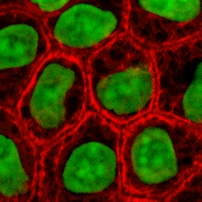Wikijunior:Life/Yesterday/Diversity
| Λ Up |
||
| <Back | Next> | |
| More V |
Find out about living things of today and living things of the past.




Diversity
[edit | edit source]Diversity means difference. The most simple single cell is the smallest unit or organism that is classified as living. Cells are often called the building block of life. Some organisms, such as most bacteria, have only one cell, and are called unicellular organism. Other organisms, such as us humans, are multicellular. In fact, we humans have an estimated 100 trillion cells ( 1014 or ten with 14 zeros).
Cells
[edit | edit source]
Most cells are round or egg-shaped and measure only ten millionths of a meter across (this is written 10 µm using the Greek character 'mu' and pronounced as 'ten micrometers'). A typical cell mass is 1 nanogram, which is one thousandths part of one millionth (10-9g or 0.000 000 001g. The largest known cell is an unfertilized ostrich egg cell or ovum which weigh about 1.25 kilos!
So cells can vary enormously in size, and also in what they do. There are two types of cells called eukaryotic and prokaryotic.
- Prokaryotic cells are usually independent, and simpler, lacking a nucleus and most of the other sub-units or organelles found in eukaryotes. There are two kinds of prokaryotes called bacteria and archaea but these both have a similar overall structure, with a whip tail or flagella and fur-like pili on the outside. Inside is the tangle of DNA which holds the genetic code.
- Eukaryotic or kernal cells are often found in multicellular organisms and are much more complex. The best known single eukaryotic cell is the amoeba which we will come to later.
The sub-cellular parts or Organelles shown in the diagram:
(1) nucleolus
(2) cell nucleus|nucleus
(3) ribosome
(4) vesicle (biology)|vesicle
(5) rough endoplasmic reticulum (ER)
(6) Golgi apparatus
(7) Cytoskeleton
(8) smooth endoplasmic reticulum
(9) mitochondrion|mitochondria
(10) vacuole
(11) cytoplasm
(12) lysosome
(13) centrioles within centrosome
For now we will stick to the simple Prokaryotic beast the bacteria. Bacteria display a wide diversity of shapes and sizes called morphologies (probably you have seen shapes change or 'morph' by computer graphics, for instance when a tiger's face changes gradually into that of an elephant. Most bacteria are either spheres or cylindrical. The bacterial cell is surrounded by a skin or lipid membrane which keeps the contents of the cell safe and acts as a barrier to hold the nutrients, proteins and other chemicals the cell.
Bacteria can absorb nutrients (food) and grow. Once a bacterium is big enough to make two smaller bacteria it splits apart, a process called binary fission, Bacteria reproduce without the need for male and female versions, and this is called asexual reproduction. Although it is very efficient and simple each of the two offspring are exact copies of the host which formed them. To modify their genetic code, or DNA requires either a faulty or incomplete fission, or else the work of a virus.
Virus
[edit | edit source]A virus is a microscopic infectious agent that is not alive but still can reproduce, but only inside a host cell. Viruses infect all types of organisms from bacteria and archaea through to plants and people.Viruses have only two or three component parts. Most importantly, all viruses have genes made from either DNA or RNA, which are the long molecules that carry genetic information, and all viruses also have a protein coat that protects these genes. Viruses display a wide diversity of shapes and sizes (morphologies) and are about 1/100th the size of bacteria.
Exactly where viruses came from is not really known, but they may have been formed in cells that broke apart without all the necessary genetic information intact. The great thing about viruses is that they can get inside a cell and reproduce themselves as parasites. Mostly this is harmless, but sometimes the process is catastrophic: that is it kills its host cell.
Between these two extremes, a viral genetic code can be mixed up with the cellular code, thus producing a new sort of cell entirely. Mostly these mutants are more complex and not well adapted, and simply die. Just occasionally though, the change gives the new type of cell a survival advantage, and a new species emerges. Probably that is how the complicated eukaryotic cells came into being.
